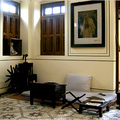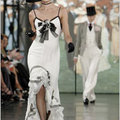
Pavel Horejsi for The New York Times
La Degustation, a Prague restaurant that only serves seven-course tasting menus, with no à la carte.
IT'S never been terribly hard to convince travelers of Prague's appeal, at least not when it comes to its architecture, music and history. Czech cooking, however, has long been viewed as the lone downside, as if Prague's delicious buffet of castles, concerts and cobblestones simply had to have a counterbalance. Locals and tourists alike have gotten by on high-end French, Italian and Japanese restaurants since the mid-90s. But recently, some restaurants here have begun taking traditional Czech cooking into new territory, treating hearty Bohemian fare with the same respect afforded classic haute cuisine.
Take La Degustation (Hastalska 18; 420-222-311-234; www.ladegustation.cz), a sleek, loungelike restaurant that opened in Prague's Old Town last November. As the name implies, there is no à la carte menu. Instead, there are just three seven-course tasting menus: one featuring Continental recipes, one composed of daily market specials and one designed around traditional Czech dishes.
When I called to reserve a table, I was told that the Czech menu, Bohème traditionnelle, came primarily from an obscure 1880 cookbook by Marie Svobodova, and was warned that I should probably cancel my after-dinner plans, as the meal itself would take around three hours. Indeed it was a full 180-minute performance of unusual (and unusually fantastic) Central European fare, starting with an over-easy “lost egg,” pan-fried with the meaty, aromatic bolete mushrooms called hriby in Czech, listed on the English menu as cèpes. After this, the procession of small dishes began with a light, clear bouillon of wild poultry, spring carrots and a rich, chicken-liver dumpling, continuing with a single ravioli, stuffed with diced beef lungs, poached in a buttery cream sauce and served with a marjoram-scented demi-glace. Beefy, sticky-sweet and sharply sour, it seemed to connect old Czech cooking with the contemporary global lust for offal.
Though the set menu comprises seven courses, there's an even greater number of amuse-bouches staggered throughout, including a savory anchovy-and-root-vegetable escabeche; a silver-dollar-size sandwich filled with garlicky beef tartare; and a shockingly white tomato meringue, topped with honey and aged balsamic vinegar. (This raises the question: just how amused can your bouche really be after eight or nine such creations?) Among all the hors d'oeuvres were more meats, mushrooms and herbs: cubes of tender smoked calf tongue with chanterelles, a slow-braised rack of lamb in sweet thyme sauce and a grilled pork belly with red cabbage (organic, no less). The dessert was a palacinka, the traditional Czech crepe, but fluffier than the standard version, made of quark, a type of cream cheese, and served with fresh strawberries and vanilla ice cream.
What was most startling was how light it all seemed, especially after three hours of constant consumption: instead of heavy starches and rich sauces, the dishes seemed to focus on building intense flavors, but presenting them in delicate portions. The staff was similarly refined, easily describing oddball Czech grape varietals while dropping off the many new dishes and refilling glasses. About the only thing that wasn't terribly light was the check, which came to about 5,000 korunas for two (or nearly $250 at 20.8 korunas to the dollar).
I spent half that amount at the restaurant U Petrske veze (Petrska 12; 420-222-329-856; www.upetrskeveze.cz), or At Peter's Tower, next to the gothic spire of that name. A set of small rooms with candles and stained glass, U Petrske veze comes off as slightly more rustic, offering such old-fashioned conveniences as an à la carte menu and the traditional, plopped-down local welcome of lard and sliced rye bread.
Beyond that, the ubiquitous Czech pork seemed to have been abandoned in favor of game. Our starters included a hearty venison pâté, topped with a sweet-and-sour, red-currant jam, filled with crunchy whole green peppercorns and bits of roasted almonds. Another starter, kulajda, a soup, brightened a rich chicken broth with loads of fresh dill, bulking it out with more cèpes, chunks of potatoes and a whole poached egg. The menu lacked the classic svickova na smetane, beef tenderloin in cream (more on this later), though in its place was a variation: zajic na smetane, or hare in cream. The sweet and tangy cream sauce was thick enough to build load-bearing walls out of, perfect for the four very fluffy knedliky, or dumplings. (Though this seemed a ridiculously small number: in the kingdom of goulash and thick sauces, four knedliky is considered the right amount for a toddler.) Falling easily from the bone, the chunks of tender dark meat contrasted the slight sourness of the sauce. Another main dish, quail medallions with pepper and rosemary, brought to mind M. F. K. Fisher's observation on the intensely fragrant nature of quail.
One of U Petrske veze's great strengths, the drinks menu, includes a hidden weak spot. Though the restaurant stocks wines from many of the best producers in Moravia (the second half of the Czech Republic, east of Bohemia and just across the border from Austria's Weinviertel), it also taps one of the country's best beers, Rohozec, a rich and malty pilsner with a pleasant, peachlike fruitiness and a minty, hoppy finish. After trying one as an aperitif, my girlfriend and I had little interest in drinking anything else. I did give in to a post-meal Bavorak, or Bavarian, a cocktail of tonic and peppery Fernet Stock, licensed from the Italian Fernet Branca and produced in Bohemia since 1927.
Despite the obvious appeal for travelers interested in traditional fare, U Petrske veze feels like a local neighborhood secret, filled with the Czech language and few English speakers.
The same cannot be said of the restaurant inside the Prague Hilton, CzecHouse (Pobrezni 1; 420-224-841-111), which started out proudly introducing local dishes to its international clientele. When I visited in August, though, it seemed to have scaled back its Czech offerings in favor of more international dishes. When asked for a recommendation of a traditional Czech starter, the waiter said, “That's the one question I was hoping you would not ask.” However, he offered to consult the kitchen for help, and returned with the suggestion of a ham roll, assuring me it was a typical Czech treat.
That might be true: I've seen hundreds of them over the years, everywhere from opera premieres to beer halls. However, this was the first I thought was very good: a slice of moist ham, rolled up with a thick filling of sour cream and chives and served with a small pond of sharp horseradish cut with sweet diced apples. This is also the first one I've paid anything close to 420 korunas for, a shockingly high price for a pub snack.
The other Czech dishes at CzecHouse are also commonly found in pubs, though the prices for these seem somewhat more justified. The svickova na smetane is surely the best in the city: true beef tenderloin (most restaurants here switched to cheaper rump roast decades ago), served in a properly sweet and tangy cream bath, topped with sour red currants and served with dumplings — again just four, though the waiters were happy to bring more, recognizing the inanity of such a meager portion. The Hilton's goulash might be the world's most exclusive: 540 korunas for an oniony, thick beef stew that lacked a bit of a real Czech goulash's mysteriously deep flavor, one which allegedly comes from using each day's leftovers to start the next batch, on and on for generations. At least CzecHouse's version is probably in accordance with European Union health codes, something that can't be said for the generations-old goulash, and the tourist-friendly setting does provide an easy way into a couple of Czech classics.
The opposite was true at Cerny Kohout (Vojtesska 9; 420-251-681-191; www.cernykohout.cz), the Black Rooster, at least at its earlier location: it earned a dedicated following way in the far reaches of the Prague suburbs. Then it moved to a more accessible location in New Town a couple of years back. The owner, Vojtech Petrik, works the stoves while his wife waits tables, creating a mom-and-pop feel that perfectly suits Mr. Petrik's at-home-in-Provence style of cooking. I once joked that Mr. Petrik's recipes were political in nature, attempting to abolish Germany forever by forging a direct connection between the Czech lands and France. On this visit he seemed to be veering toward Asia, however, with a fish soup that would not seem out of place in a Korean diner: a savory, clear broth filled with deeply satisfying chunks of salmon, shallots, carrots and trout.
A main course, duck “confit,” had a richly sweet-and-sour skin and was served with a buttery, dessertlike baked green apple. Though tender and moist, it was not a confit in the classic sense of the word, and despite the appearance of more cèpes, it tasted less like a French duck than one from Peking. (It was also almost inappropriately delicious, causing me to moan loudly more times than is proper in a public dining venue.) Another main course seemed like a gamekeeper's recipe: a tender venison tenderloin paired with a slice of seared goose liver, fragrant sautéed shallots and chanterelles, sweet roast chestnuts and a syrupy raspberry sauce brightened by marjoram and thyme.
There's a lovely homey nature to the dishes at Cerny Kohout. As she cleared away a few plates, Mrs. Petrikova noted that all of the cèpes they were using came from the three kilos she and her husband had gathered in the Czech forests the previous weekend; they hadn't been so lucky with chanterelles and had to buy those. Even our dessert palacinka seemed like something straight from Grandma's house, at least at first glance, but then we noticed the hot plums inside the crepe were counterbalanced by a sweet plum ice cream — a traditional flavor here in the land of slivovitz and plum pies, but served up in a new recipe.
In many ways, the modest Cerny Kohout is probably the best of the bunch: though it can't match the shoot-the-moon variety (and prices) at La Degustation, it, too, shows that Czech food is opening up to new things, though still strongly based on local traditions.
It will almost certainly never supplant Prague Castle, the Charles Bridge, Wenceslas Square and great pilsners as Prague's top draw. But at this point, Czech food is far from a downside.






